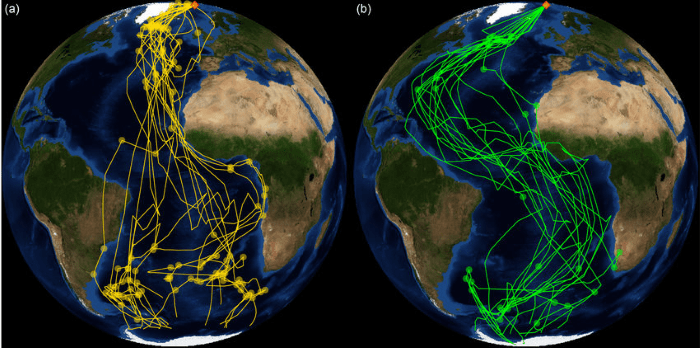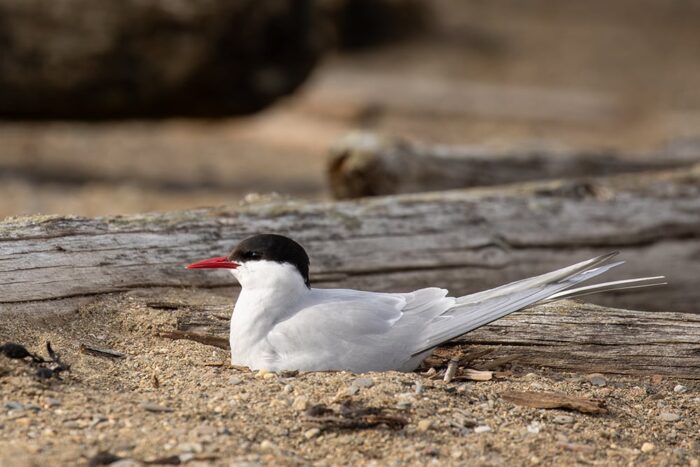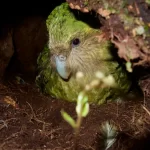The Arctic Tern is known for having the longest migration of any bird in the world. This small seabird breeds in the Arctic during the summer months and spends its winters in the Antarctic, traveling over 40,000 miles every year on its round trip migration. Scientists have long been fascinated by the incredible navigation systems and endurance that allow Arctic terns to complete this remarkable journey across the globe annually. In this article we talk about Understanding the Migration Patterns of Arctic Terns.
By studying the migration patterns of Arctic terns over decades, researchers have gained valuable insights into these sea travelers. Tracking technology has enabled scientists to map out the specific routes individual birds take, revealing that while there are some common migratory pathways, each tern may follow a slightly different route based on factors like weather and food availability.

Breeding in the Far North
During the summer months between May and August, Arctic terns gather together in large breeding colonies in coastal areas scattered across the far northern reaches of North America, Europe, and Asia. They nest on small islands and remote shorelines in places like northern Canada, Greenland, Svalbard, Siberia, and Alaska where they take advantage of abundant food sources and 24 hours of daylight.
Female Arctic terns lay just one or two eggs per breeding season. Both parents participate in incubating the eggs for around three weeks and later feed the hatchlings. The young terns are ready to fly at four weeks old but continue to be fed by their parents for another one to three weeks as they grow strong enough to migrate on their own in late August or early September. The adult terns leave soon after, not even staying to complete the breeding season before embarking on their southern journey.
Southern Migration Routes
Arctic terns follow a general pattern as they migrate from their Arctic breeding grounds towards Antarctica, but each bird may take a slightly different route towards this southern destination. Some fly down the coasts of North America or Western Europe, venturing over the Atlantic towards Africa before turning east and crossing the Indian Ocean to finally reach Antarctica. Others traverse Asia, flying over India and Southeast Asia across Australia and New Zealand before the final southward push.
In studying the migration habits of individual Arctic terns, researchers have discovered just how adaptable their routes can be. The birds demonstrate problem-solving intelligence by modifying their course based on weather patterns, ocean currents, and other dynamic conditions. If they encounter strong headwinds or storms, they are capable of changing direction to find more favorable conditions. By tracking an individual tern named Cocorico, scientists found she took a different path on her fall migration versus her spring return trip.
Navigation Across Oceans
One of the most impressive aspects of the Arctic tern’s migratory abilities is its skill in navigating across vast oceans and seas to find specific wintering and breeding grounds year after year. In cloudy conditions or at night far from land, the birds cannot rely on visual landmarks, so they demonstrate advanced sensory capabilities.
Research indicates Arctic terns utilize the earth’s magnetic field through a physiological process to orient themselves. By calibrating magnetic intensity and angles, they create an internal map and compass to guide themselves across thousands of miles, even pinpointing the exact island where they previously nested. The birds also appear to use the sun’s position and patterns of polarized light from the sky to stay on course. And they likely orient by the stars on clear nights.
The long lifespan of Arctic terns, some living over 30 years, also gives them an advantage for honing and retaining their mental maps between yearly trips. Their navigational systems and memory guide them to migrate much further than most species are capable of.
Wintering in the Antarctic
While Arctic terns may start their southern journey at different points and take varying routes, they all converge by December and January in the waters around Antarctica to spend the winter months in the Southern Ocean. They benefit from Antarctica’s long days and extended twilight. The waters also remain relatively free from ice, providing the terns with abundant sources of fish, krill and squid.
The birds remain largely at sea during this time, only periodically stopping on ice flows and shorelines to rest. In Antarctica, Arctic terns have been recorded diving over 200 times a day to catch food, benefiting from milder temperatures that allow them to stay active. They will start their northern return to the Arctic around late February and March. Their wintering period in Antarctic waters lasts between four to five months until increasing daylight triggers their breeding instincts to migrate back north.
Return Migration North
As with their original southern journey, Arctic terns don’t follow one uniform route back to their northern breeding grounds in spring. But patterns demonstrate they often trace a different path than their previous fall migration. Some fly northwest towards Madagascar and across Africa through the Atlantic. Others traverse the Indian Ocean and Asia. Many birds move earlier than necessary to reach Arctic nesting sites, apparently in order to take advantage of early spring ocean productivity to feed and build up fat stores for the breeding season.
The terns once again rely on their advanced sensory capabilities to target their northern destinations. And it’s thought they also use scent cues to navigate towards breeding colonies where past nest sites, potential mates and others of their species await their arrival. The birds recognize and return to their former territory, and most even reunite with their previous mate from up to three years earlier.
Threats Facing Migrating Terns
Arctic terns face a number of threats, both natural and man-made, during their extensive migrations across the globe. Changing ocean temperatures and diminished food sources due to climate change disrupt their journey and affect their breeding success. Oil spills contaminate habitat and poison birds. Floating plastic resembles food items and is often consumed by mistake. Commercial fishing nets entrap and drown terns. And human encroachment on coastal breeding areas has reduced habitat.
While Arctic terns demonstrate incredible resilience in their marathon migrations year after year, their populations are declining. Further research and conservation efforts focused on protecting habitat, reducing pollution, and limiting fishing impacts can help ensure the survival of these global travelers into the future. Tracking studies that reveal migration timing, routes, wintering areas and other data points are key for identifying critical places and periods where protections are most vital across the Arctic terns’ vast range. Maintaining populations of these epic migrators represents a conservation success story for the ages due to the bird’s expansive territory across hemispheres. Their exceptional navigational prowess and physical endurance pushes the boundaries of what’s possible in the natural world. I sincerely hope you find this “Understanding the Migration Patterns of Arctic Terns” article helpful.
If you enjoyed this article, you might also read this: The Ultimate Guide to Raising Chickens in Your Backyard Like a Pro

Stina is the expert behind BirdFacts.net, dedicated to sharing her passion and knowledge about birds. With a degree in Environmental Science and over 6 years of birdwatching experience, she brings both expertise and enthusiasm to her writing. Stina’s work aims to inspire appreciation for birds and promote responsible birdwatching. Follow her bird-filled journey on Instagram.





